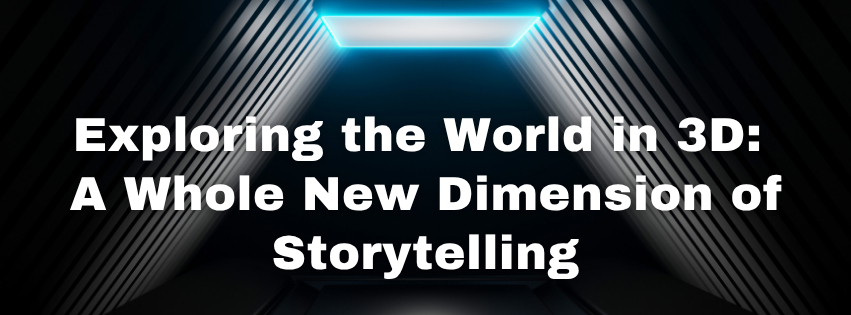
Exploring the World in 3D A Whole New Dimension of Storytelling

Are you ready to stop just reading or watching stories and start living them? Forget flat screens and passive viewing! We're diving headfirst into an amazing new world where stories jump out at you in 3D, pulling you right into the heart of the action.
Welcome to 3D storytelling, where your imagination comes alive and you're not just an audience member, but a part of the story itself.
So, What Exactly is 3D Storytelling?
Think beyond traditional books or movies. 3D storytelling uses incredible three-dimensional visuals, augmented reality (AR), virtual reality (VR), and interactive digital spaces to tell stories that are super engaging and totally immersive.
Instead of just looking at a screen, 3D formats put you inside the story. You can explore different environments, chat with characters, and even influence what happens next. It’s a huge leap from simply watching to actively experiencing – and it's taking off everywhere, from schools and entertainment to marketing and even your favorite mobile apps.
Why 3D is revolutionizing the Way We
Deliver Stories
That’s why 3D storytelling is becoming the medium of choice for brands,
teachers, and makers:
1. Immersive experiences create
greater engagement
Studies
prove that more immersive 3D experiences form more effective emotional
attachments. When you feel like you're actually inside a story – walking
around, talking to characters – you connect with it way more deeply. You'll
remember it better and care about what happens.
2. Effective learning instrument for students
Interactive 3D worlds facilitate learning that is more efficient, effective,
and engaging. Just imagine students moving through a virtual museum, studying
ancient civilizations via AR, or understanding abstract science concepts
through 3D models. Such is impact storytelling.
3. Brand Storytelling Upgraded
nowadays, many businesses are already utilizing 3D storytelling for advertising to showcase their products in new, innovative, and immersive means. Whether a virtual try-on of a garment, an interactive demo of a product, or a social media branded AR filter—3D content raises engagement, every time, complemented with conversion rates.
Apps like PhotoTube.app are giving rise to 3D-enhanced content creation for businesses and creators, intertwining storytelling with modern technology to deliver live digital experiences. From 3D-animated images to interactive settings through the use of AR, these are giving rise to new possibilities for businesses and storytellers.
Applying 3D Storytelling
Let us now observe how 3D storytelling is transforming other
sectors:
- Entertainment: Entertainment and video games are merging with virtual 3D worlds. Movies like Avatar: The Way of Water and virtual reality game Half-Life: Alyx illustrate the shared intensity that strong 3D images can bring to storytelling.
- Education: Schools, universities are implementing AR and virtual reality learning environments, which are giving learning a more immersive feel and boosting retention.
- Marketing: Brands like IKEA, L’Oréal, and Nike are employing AR product previews and 3D commercials for virtual trial experiences for customers.
- Medicine: Physicians use 3D simulations to train, diagnose, and even operate more accurately.
- Publishing: With platforms like PhotoTube.app, publishers are supplementing classical stories with augmented reality layers, converting children's books, cartoon stories, and study content into 3D interactive experience.
3D Narrative Challenges (and How to
Overcome Them)
While the potential is staggering, 3D storytelling is not without difficulties:
- High Costs of Production
- Technical specialties are a must
- Hardware constraints (especially for VR)
- Slower adoption with less tech-savvy audiences
But new platforms and tools are making that possible. Apps like PhotoTube.app allow content creators to add 3D and AR dimensions to their already-existing content without needing to learn involved coding or invest expensive gear—unlocking immersive storytelling for all.
The Future: What Storytelling Has In
Store
As spatial computing, AI, and AR glasses continue to gain popularity,
boundaries between the virtual world and the real world will only diminish
further. What we are moving towards is a day when stories are:
- In reaction to our actions
- Integrated into day-to-day contexts
- Everywhere possible via wearable devices
Storytelling in this new world will not only be a mode of communication but something that surrounds us and reacts.
Conclusion
we are not limited anymore to storytelling on flat pages or flat monitors. With
3D storytelling, we can now walk through our imagination, explore ideas, and
interact with content like never before. Whether you are an educator, a brand
marketer, a creator, or a content producer, now is your time to unlock this new
form of storytelling.